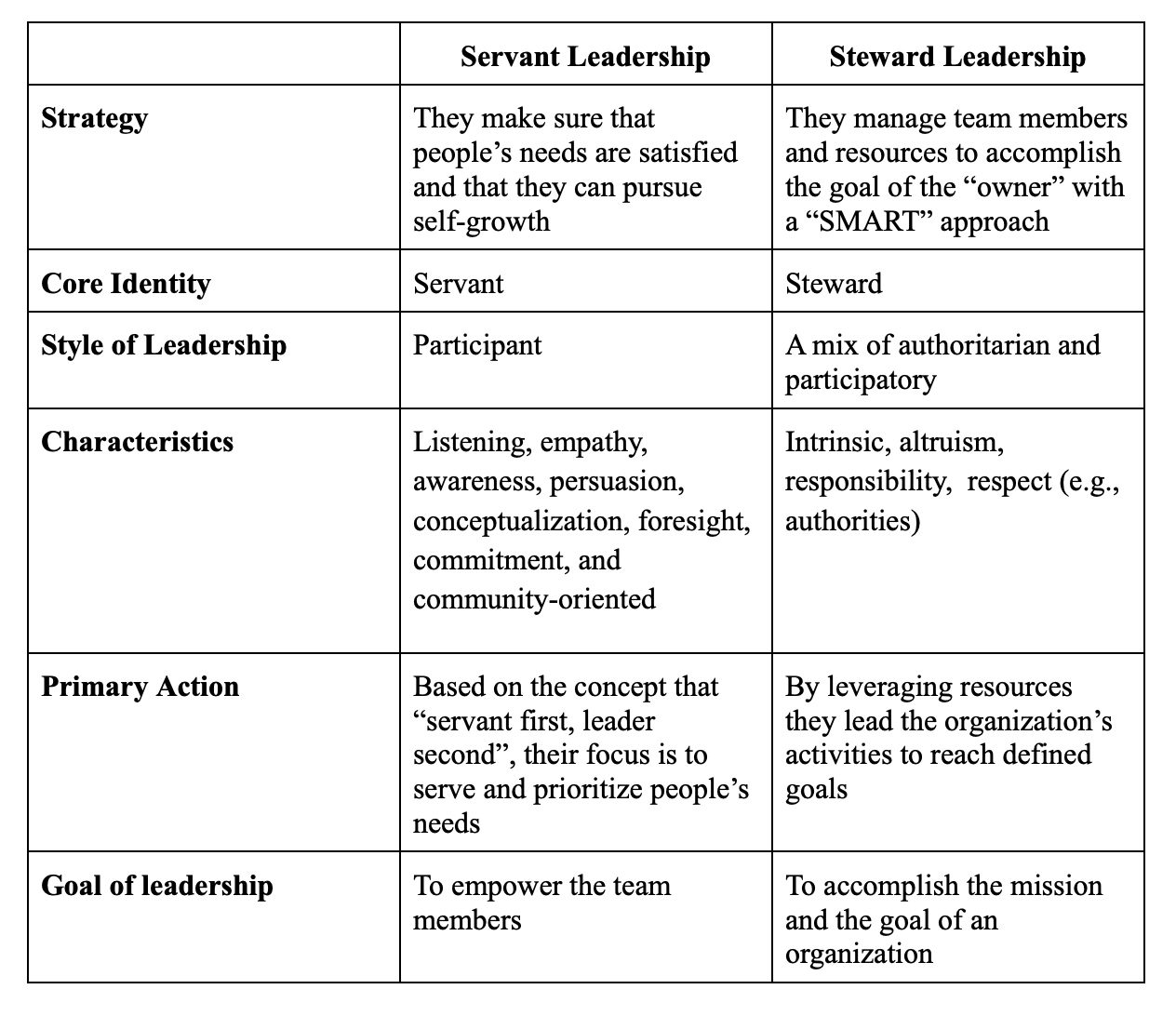
Steward Leadership: a Synergic Approach for a World with a Future
Nine essential components were identified for a steward leader, such as personal and shared vision, personal mastery, mentoring, vulnerability and maturity, valuing diversity, experimentation and risk-taking, raising awareness, and delivering results.
“Twenty-first-century leadership relationship dynamics are from the bottom up rather than the top down; from the outside in, rather than the inside out.” (James M. Strock)
A few months ago, I attended the Syntropic Enterprise Masterclass by Christine McDougall. One thing that caught my attention was the concept of Steward Leadership to create rooms to evolve innovative ideas for a world with a future. Unlike authoritarian leadership made of control and domination, steward leadership creates spaces and places with care, intention, and attention to empowering human synergy and teamwork.
This synergic approach protects source ideas and their pattern integrity of the enterprise being stewarded through the team, the community, the environment, and the vibes of the emerging future, where trust, responsibility, and accountability are the values that make this synergy possible. Hence, steward leaders run an enterprise as if they own it because they believe in the organization's culture, mission, vision, and values.

What is “Steward Leadership”?
Initially proposed by Dr. Robert Clinton in 1987, a steward leader is “someone who manages the efficient use and growth of organizational resources, and leads the staff and activities of the organization as a steward, to achieve the mission according to the objectives of the owners or stakeholders.” Indeed, the etymology of the word stewardship is to be a guardian of the home.
Steward leadership has an old history starting in ancient Greece, Rome, and Israel, where stewards leaders were responsible for running commercial activities, enterprises, farms, and political services with the trust and confidence of the owner. Thus, a steward leader operates with a different mindset to fulfill the needs of different stakeholders and according to the mission of an organization (or corporate enterprise). Although steward leadership may benefit from the results of an effective leading style, the most important aspect to consider is the value that this leadership style brings to the owner. Therefore, to act as a steward leader, a few attributes, behaviors, and perspectives were considered:
- Knowing the owner's mind: steward leaders are empowered by the owners, stakeholders, and community when leading a project. Indeed they are empowered with a role, resources, and authority. This means the capability of assuming responsibilities, empathy, and perceiving what the owner expects based on their goals and resource management. Besides, they can foster a sense of humility and help while preventing pride from taking over.
- Accountability: Being responsible for managing projects, a steward leader is accountable for managing the resources and the operations of an enterprise. Accountability can refer to finances, managing people, but also the achievement of the mission. Consequently, steward leaders must account for their actions and outcomes (e.g., to a Board of Directors, the owner, or a large group of stakeholders/shareholders).
- A modern way of being a “servant”: differently from the past, steward leaders are no longer servants but “serve” the owner to accomplish a mission and benefit others. Therefore, they are aware that their role is “time bounded,” and they do not see their position as permanent. Instead, they are ready to leave their role and pass it to another steward while transiting to another position.
- Managing and exploiting resources: besides the interests of business growth, steward leadership also involves personal development through learning new skills. In addition, this includes mentorship activities to promote the organization (enterprise, small corporate) culture and the development of team members. This requires a high responsibility and the capability of exploiting resources. In addition, they focus on achieving long-term goals while managing short-term needs that will definitely lead to their moonshot.
- Mentoring others: steward leaders collaborate within a team, and together they are driven by the same mission and mindset, in which anyone has a role in accomplishing the goals of an organization (enterprise, small corporate). Furthermore, their positive example guides and mentors, others to become future stewards.
Engaging teams in line with mission, vision, and values.
Team engagement is key for a successful business. Indeed, research demonstrated that 60% of employees who feel demotivated and disengaged would be willing to quit. Therefore, steward leadership invests in team engagement while considering their financial and well-being. Indeed, when employees feel appreciated, respected, and valued, they will embrace and foster the organization's mission, values, and vision with high motivation and commitment. Accordingly, in the book by Julia Kukard, Kurt April, and Kai Peters (2013) called Steward Leadership: A Maturational Perspective, steward leadership is defined as “a form of leadership that focuses on others, the community, and society at large rather than the self” thus indicating how this style of leadership develops naturally throughout the course of one’s career (e.g., the leader learns to know the needs of a team, how to raise productivity based on the team skills and forces, respect the team and empathize with them).
So which are those essential characteristics that a steward leader must acquire?
Nine essential components were identified, such as personal and shared vision, personal mastery, mentoring, vulnerability and maturity, valuing diversity, experimentation and risk-taking, raising awareness, and delivering results; skills that would transform into an attitude toward leading. Moreover, steward leadership values and promote trust by empowering the team and their key roles in achieving the goal of an organization, although it takes time and self-growth to build trusted and effective relationships. Therefore, steward leaders rely on emotional intelligence and understand that people are a major resource to invest in. Empathy, trust, and respect are three essential elements for a sustainable and successful business, and avoiding adapting to this mindset risks an organization’s failure. Steward leaders care and operate for the benefit of stakeholders, and the community. Indeed, John F. Kennedy said, “Ask not what your country can do for you, but what you can do for your country.” A good example is the COVID-19 crisis. Throughout the pandemic, steward leaders demonstrated the capability of supporting employees by delivering a series of services and incentives, letting them feel assisted and understood regarding their needs (e.g., initiatives for families), and with a positive effect on their mental and emotional health (e.g., wellness programs).
Stewardship benefits the health of a company and consequently has a ripple effect on society and the community because a steward leadership invests in an organization's culture by inspiring the team to share the same vision, values, and mission, which in turn enhances the productivity and the business success. Not surprisingly, Bob Chapman, the CEO and Chairman of Barry-Wehmiller, mentioned that how we treat our team members impacts how they treat their family at home and everyone in their lives.
A powerful and effective approach to rising 10x value
Besides being an area of research, in a previous article, I discussed how leadership can also be a set of skills concerning the ability of an individual, group, or organization to lead and influence other individuals, groups, communities, or entire enterprises. Indeed, various leadership styles were presented to explain different methods of giving direction, guidance, actuating plans, and inspiring and motivating single individuals and communities toward the achievement of a goal. In addition, different theories were discussed to understand why certain individuals become successful, effective, and influential leaders. Therefore, there is not only one way to take the lead. Instead, leadership styles can be seen as tools, and leaders might have a favorite one to grab, although some styles might results more effective than others in achieving a certain goal.
Among these, stewardship operates in profit and non-profit businesses, showing quite distinctive characteristics. Indeed, I previously described five relevant attributes for example, the ability to recognize that they work on behalf of others (e.g., the owner), are accountable, work on long-term goals, and are aware that their role as a steward has a time limit. Lastly, they mentor others to become, as well, steward leaders. In addition, stewardship means taking care of the people, resources, and responsibilities under the leader’s influence and direction. Thus, three major qualities have been recognized in steward leaders such as caring, clarity, and coaching.
Caring
Steward leaders focus on people to leverage and achieve results. They do this by taking care of each individual in their team and by engaging them in activities and responsibilities. They value trust, empathy, and respect and they build effective relationships. Indeed, J.W. Marriott said, “If you take care of your people, they will take care of your customers and your business will take care of itself.” But how can a leader show interest and care for his/her team members? A few tips are:
- Listen to their story and learn from it: steward leaders ask simple questions to gather insight and better know their team members (e.g., what they like, and what they do not like) to improve their collaboration.
- Organize recreational activities outside work: steward leaders organize meetings outside the office environment (e.g., a dinner, a party, a movie) to engage their team and build solid relationships.
- Recognize and value team members: steward leaders recognize the effort of their team members individually, and they do it by asking, “how do you like to be recognized?” This has the effect of letting team members feel valued and estimated for their work and capabilities while making them proud of being part of the team.
- Regularly organize one-to-one meetings: steward leaders regularly organize personal meetings to build trusted relationships and to give clear directions and guidance.
- Understand their needs: steward leaders understand and listen to the needs of their team, and they go for it. A more engaged and collaborative team is a positive consequence.
Clarity
A great quality of stewardship is clarity. Steward leaders are clear about what they want to achieve and which are their expectations, and they communicate them to the team. They are crystal clear by
- Agree on goals: steward leaders encourage team members to set their own goals. Through guidance and mentorship, leaders help them to re-direct and finalize their goals while supporting them in this achievement.
- Set SMART actions: steward leaders act clearly by relying on the SMART formatting. Thus they define specific, measurable, attainable, relevant, and time-bound goals.
- Adopting flexibility: steward leaders supervise and are flexible to reset and reschedule goals. They communicate clearly with the team and they evaluate the progress. If a goal looks no longer relevant (according to the SMART format), it’s time to be adjusted for higher performance.
Coaching
Steward leaders are coaches. They challenge and inspire the team. They plan, set SMART goals, and give clear directions. They give one-to-one feedback and mentor others. According to their mindset, the force of the team is more than the sum of each member (“when one plus one equals one thousand”). Therefore, they invest in the team to achieve successful results in line with the value, vision, and mission of the organization. Thus steward leaders coach by:
- Asking: steward leaders empower the team by giving them autonomy. They ask questions to the team (e.g., what do you think about…?) instead of giving orders and telling them what to do.
- Let the team find a solution: steward leaders define why the work matters and what needs to be accomplished. They don’t tell how to do a certain task but leave the team to figure it out. Indeed, a good way to learn is to fail and try again with a different approach. Nevertheless, leaders are always there to support and promote their creativity and ideas.
- Give feedback frequently: steward leaders give feedback to push the team talent letting them know when they do “right” or “wrong.” This is a good approach to learning, improving, and achieving results at a fast pace.
Despite stewardship sounding so effective and truly engaging, what’s the risk of adopting this leadership style? It is definitely demanding and expects anything in return. However, despite these challenges, steward leadership have a great effect on the team while growing and developing their skills. Lastly, by care, clarity, and coaching, leaders are capable of aligning the team within the scope of an organization while reaching outstanding achievements.
The “because/therefore” leadership model
Stewardship is a clear and defined model of leadership. Different from other styles characterized by an “if/then” (outcome-based) approach, steward leaders adopt a “because/therefore” mindset. This is indeed a unique perspective in which “because” (transcendence) leads to “therefore” (personal investment). Their personal transcendence is the driver, and stewards are the agents, investing their energies in something bigger than themselves. They focus their attention on themselves and their skills, and not on the outcome (e.g., “because I value x, I expect myself to do Y”). Consequently, this model would lead to faster and more effective decisions made based on a set of recognized values. Moreover, steward leaders reflect this mindset while caring more about their successors than they do about success. Indeed, they are aware that their role is just temporary thus they concentrate their energy and resources on their team because together is key to reaching goals. They have a purpose and they act accordingly to generate something meaningful and engaging. And that’s why stewardship is effective and powerful.
How does it differ from “Servant Leadership”?
Steward leadership didn’t receive the attention that servant leadership had over the years. However, although these two approaches may share similar characteristics and assumptions, they are different and serve different purposes.
The term “servant leadership” was coined to define a style in which the leader serves the team members; a completely opposite approach compared to traditional leadership styles. The first time that this approach was implemented goes back to 1970 by Robert Greenleaf. While servant leadership is mainly focused on the growth and well-being of people and communities by sharing power and helping people to develop, steward leadership cares for the team, the organization, or society by acting according to the interest of the organization, thus sharing its mission, vision, and values. Indeed, stewardship focuses on attracting and growing talents with the same mindset and values, and their major role is managing resources to accomplish their goals.
Nevertheless, servant and steward leadership have been usually confused, and these terms have been frequently exchanged, although they mean different approaches to leadership. So, in what do they differ?

Despite similarities concerning motivation and leadership characteristics, they serve a different purposes and lead to different outcomes. For instance, servant leadership fails to address key aspects of organizational leadership (e.g., the accomplishment of the owner’s goal, resource management, and accountability).
Start today with 5 simple steps
Having discussed which are the major components that characterize the personality, attitude, and behavior of steward leaders and how this leadership style differs from a traditional or servant leadership approach, which are the first steps to put into practice these learning?
Step 1: Reverse your perspective. Start using “we” instead of “I.”
Step 2: Focus on long-term goals. Having in mind a clear big picture would be essential to pursue the goal and success of an organization.
Step 3: Understand, embrace, and empower the core values of the organization (e.g., financial, ethical, sustainability, product quality, etc.), even though they may be in contrast with your personal perspectives (e.g., recognition, salary, visibility) and attitudes.
Step 4: Align your work and core activities to match the values, mission, and vision of the organization.
Step 5: Recognize which are the short-term goal, but be prepared to guide and align the team activities toward the achievement of long-term results.
Last but not least: Steward leadership is contagious. This means that by focusing on encouragement and engagement, steward leaders would positively influence the team to adopt and acquire the same mindset, attitude, and behavior. Employees may start feeling empowered and motivated to complete tasks that go beyond requests, resulting in innovation and a different strategic approach to fulfill the tasks and needs of an organization. This translate into the culture of stewardship, as described in the book by Eric Douglas called The Leadership Equation.
How do I know if my stewardship style is effective?
To ensure that you are leading people on the right path with the right values and resources, you may ask yourself a few questions:
- Do my team member know WHY we are together?
- How do we behave as a team (e.g., especially in difficult situations)?
- Do we prioritize and care about their health, needs, and well-being to achieve the organization's purpose?
- Is our communication crystal clear?
- Do our actions demonstrate our intentions and the leaders we want to be?
- Are our decisions according to an appropriate time, context, and place?
If our stewardship is good enough, signs of synergy will appear because people inside the team will cooperate to co-create and realize projects in a highly functional manner. The intervention of a leader would become almost minimal. In conclusion, to develop and grow as steward leaders requires the willingness to release the control by learning how to trust your team and how to exploit power to generate synergy, and where the structure of the enterprise is based on comprehension. Clarity, transparency, investment of valuable actions, empathy, mutual care, and support.
“People do not care how much you know until they know how much you care.” (John C. Maxwell)

ExO Insight Newsletter
Join the newsletter to receive the latest updates in your inbox.









